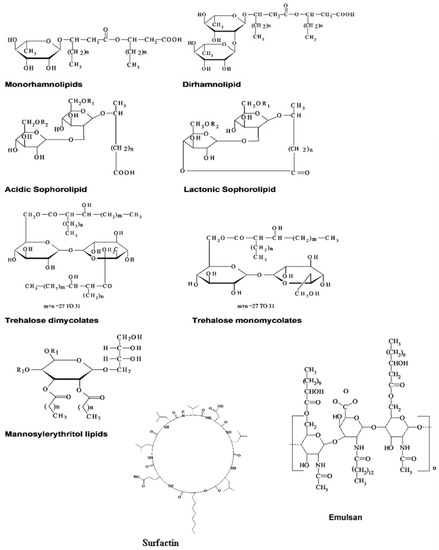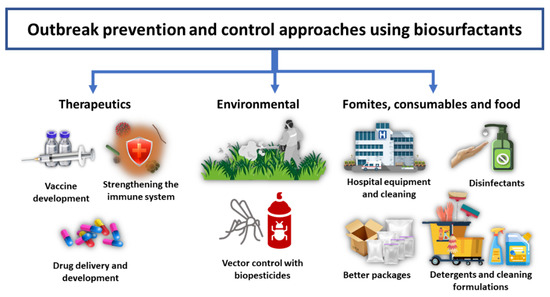Biosurfactants can play a significant role in the prevention, control and treatment of diseases caused by a range of pathogenic agents through various therapeutic, pharmaceutical, environmental and hygiene approaches.
- biosurfactants,antiviral
- antimicrobial, COVID-19,
- biosurfactants
- antiviral
- antimicrobial
- COVID-19
1. Biosurfactants
Biosurfactants are amphiphilic compounds synthesized by bacteria, fungi, or plants, capable of lowering the surface tension of liquids. Their hydrophilic moieties can be made of acid, cationic peptide, anion, sugar (monosaccharide, disaccharide, or polysaccharide) and hydrophobic moieties made of hydrocarbon or fatty acid chains. They are environmentally friendly and have been shown to have many industrial applications sometimes performing better than synthetic surfactants [1][2][3][4][5]. Their physico-chemical properties include; high stability in a wide range of environmental conditions such as extreme pH, temperature and also salt concentration [6][7], high biodegradability with a high rate of mineralization by soil microcosms [8], low toxicity, surface tension reduction, foaming capacity and antimicrobial activity against pathogens [9][10][11][12].
Well known classifications of biosurfactants are based on their charges and molecular structures. Biosurfactants obtained from microbes are generally anionic or neutral, while a few are cationic [5]. Long-chain fatty acids generally characterize the hydrophobic moiety, while organic acid, alcohol, amino acid or carbohydrate functional groups characterize the hydrophilic moiety [5]. They are also broadly grouped based on their chemical structures as high molecular weight and low molecular weight molecules. Low molecular weight molecules are the glycolipids, phospholipids and lipopeptides, while the high molecular weight groups are the polymeric and particulate biosurfactants [13] (
). In addition to their environmental friendliness and wide industrial applications, biosurfactants are more sustainable because they can be produced from cheap feedstock and industrial and urban waste, and can be recycled [14][15]. However, there are still challenges such as the pathogenicity of the main biosurfactant producer strains
and
and the relatively higher cost of large-scale production that make biosurfactants less commercially competitive than petroleum-derived synthetic surfactants [16]. Nevertheless, there is a growing scientific research interest in the improvement of the commercial competitiveness of biosurfactants. Bacterial strains are being engineered, new feedstocks are tested, and fermentation designs investigated to develop innovative ways to improve production efficiency. Amidst these challenges, it is expected that biosurfactants will occupy a significant market share, which is projected to be about USD 5.52 billion by 2022, growing at a CAGR (compound annual growth rate) of 5.6% [17].

Representative biosurfactants produced by microorganisms utilizing water-soluble and /or water-insoluble substrates [1].
2. Pathogens and Other Agents with Outbreak or Pandemic Potential
RNA viruses are the class with the highest risks of an outbreak especially those that are airborne such as severe acute respiratory syndrome coronavirus 2 (SARS-CoV-2), because the mere act of breathing spreads the virus. Other organisms could potentially evolve or be engineered through drug resistance or human manipulation. With these factors in mind, the development of pipelines for both broad-spectrum and specific therapeutics could be important to add resilience against outbreak-causing pathogens. The first line of treatment for these emerging diseases can be broad-spectrum antimicrobials, while specific treatment options could benefit from modifications that diversify the mechanism of action of such therapeutic molecules. This can also be integrated with other environmental approaches that disrupt transmission from the common source of spread in the population [18]. According to a report by the Intergovernmental Platform on Biodiversity and Ecosystem Services, there are over 1.7 million viruses unknown to man, with 540–850 thousand that can potentially infect humans. The cost of risk mitigation for these pandemics could be 100 times less than the cost of pandemic management. If the status quo on the fight of infectious diseases is not changed, we may see more outbreaks in the future with more damaging effects [19]. Some currently known diseases with high pandemic or outbreak importance include; Crimean–Congo hemorrhagic fever, chikungunya, cholera, Ebola virus disease, influenza (seasonal, zoonotic, pandemic), Hendra virus infection, Lassa fever, meningitis, Marburg virus disease, MERS-CoV, Nipah virus infection, monkeypox, novel coronavirus (2019-nCoV), SARS, smallpox, Tularaemia, plague, Rift Valley fever, Yellow fever and Zika virus disease [20]. Important bacterial-resistant strains include
,
and
, among others [18].
3. Approaches That Can Use Biosurfactants in Outbreak Prevention and Management
There are various areas where biosurfactants can be used as alternative sustainable solutions or as innovative components applicable in outbreak prevention and management. These include uses in therapeutics (vaccine development, immune system enhancers and drug delivery and developments), environmental applications as agricultural and pest biopesticides, and various industrial sectors as surface cleaning agents, disinfectants, detergents, and the packaging industries. All these applications are summarized below in Figure 2, and further discussed in the following subsections.

A summary of potential approaches for applications of biosurfactants in future outbreak prevention and control.
4. Therapeutics
Treatment availability is the most important element for the elimination of an outbreak, because the pathogen can be eliminated, thereby interrupting the transmission cycle and impeding the spread. However, the development of an effective drug against a disease takes years due to the required clinical trials and approval processes. Using already-approved low toxicity molecules or repurposing existing drugs to target a new pathogen can contribute to the development of effective therapy in a shorter time. Biosurfactants are one of the most promising biomolecules in the pharmaceutical industry because of their structural versatility, stability, micelle forming ability, biological compatibility and low toxicity that are useful in the design of therapeutics. They can be safely used for oral, nasal, or dermal applications [23][21]. Another important characteristic of biosurfactants is their ability to interact with surfaces such as the membranes of organisms or with their surrounding environment, which can be useful in intracellular targeting.
Lipopeptides, glycolipids, and Mannosylerythritol lipids produced from Candida species are the most common microbial surfactants that have been investigated for pharmaceutical applications. They are relevant in pharmaceuticals for the delivery of drugs and genes to target cells, the design of molecules to interact with components of the immune system, and as antimicrobial agents. Biocompatibility, low toxicity, and environmental friendliness are advantages that make them better options over synthetic surfactants [18,24,25,26][16][22][23][24]. Biosurfactants have various innovative applications in the development of effective therapeutics which can come in handy at times of urgent need, such as during outbreaks or pandemics.
References
- Banat, I.M.; Franzetti, A.; Gandolfi, I.; Bestetti, G.; Martinotti, M.G.; Fracchia, L.; Smyth, T.J.; Marchant, R. Microbial biosurfactants production, applications and future potential. Appl. Microbiol. Biotechnol. 2010, 87, 427–444.
- Banat, I.M.; Makkar, R.S.; Cameotra, S.S. Potential commercial applications of microbial surfactants. Appl. Microbiol. Biotechnol. 2000, 53, 495–508.
- Çakmak, H.; Güngörmedi, G.; Dikmen, G.; Çelik, P.A.; Çabuk, A. The true methodology for rhamnolipid: Various solvents affect rhamnolipid characteristics. Eur. J. Lipid Sci. Technol. 2017, 119, 1700002.
- Marchant, R.; Banat, I.M. Microbial biosurfactants: Challenges and opportunities for future exploitation. Trends Biotechnol. 2012, 30, 558–565.
- Sobrinho, H.; Luna, J.M.; Rufino, R.D.; Porto, A.; Sarubbo, L.A. Biosurfactants: Classification, properties and environmental applications. Recent Dev. Biotechnol. 2013, 11, 1–29.
- Ben Ayed, H.; Jridi, M.; Maalej, H.; Nasri, M.; Hmidet, N. Characterization and stability of biosurfactant produced by Bacillus mojavensis A21 and its application in enhancing solubility of hydrocarbon. J. Chem. Technol. Biotechnol. 2014, 89, 1007–1014.
- Perfumo, A.; Banat, I.M.; Marchant, R. Going Green and Cold: Biosurfactants from Low-Temperature Environments to Biotechnology Applications. Trends Biotechnol. 2018, 36, 277–289.
- Lima, T.M.S.; Procópio, L.C.; Brandão, F.D.; Carvalho, A.M.X.; Tótola, M.R.; Borges, A.C. Biodegradability of bacterial surfactants. Biodegradation 2011, 22, 585–592.
- Akbari, S.; Abdurahman, N.H.; Yunus, R.M.; Fayaz, F.; Alara, O.R. Biosurfactants—A new frontier for social and environmental safety: A mini review. Biotechnol. Res. Innov. 2018, 2, 81–90.
- Hirata, Y.; Ryu, M.; Oda, Y.; Igarashi, K.; Nagatsuka, A.; Furuta, T.; Sugiura, M. Novel characteristics of sophorolipids, yeast glycolipid biosurfactants, as biodegradable low-foaming surfactants. J. Biosci. Bioeng. 2009, 108, 142–146.
- Liu, J.-F.; Mbadinga, S.M.; Yang, S.-Z.; Gu, J.-D.; Mu, B.-Z. Chemical structure, property and potential applications of biosurfactants produced by Bacillus subtilis in petroleum recovery and spill mitigation. Int. J. Mol. Sci. 2015, 16, 4814–4837.
- Toptaş, Y.; Çelikdemir, M.; Tuncer, C.; Şahin, Y.B.; Çelik, P.A.; Burnak, N.; Çabuk, A.; Bütün, V. Optimization of a biosurfactant production from bacteria isolated from soil and characterization of the surfactant. Turk. J. Biochem. 2016, 41.
- Shoeb, E.; Akhlaq, F.; Badar, U.; Akhter, J.; Imtiaz, S. Classification and industrial applications of biosurfactants. Acad. Res. Int. 2013, 4, 243–252.
- Banat, I.M.; Satpute, S.K.; Cameotra, S.S.; Patil, R.; Nyayanit, N.V. Cost effective technologies and renewable substrates for biosurfactants’ production. Front. Microbiol. 2014, 5.
- Henkel, M.; Müller, M.M.; Kügler, J.H.; Lovaglio, R.B.; Contiero, J.; Syldatk, C.; Hausmann, R. Rhamnolipids as biosurfactants from renewable resources: Concepts for next-generation rhamnolipid production. Process. Biochem. 2012, 47, 1207–1219.
- Naughton, P.J.; Marchant, R.; Naughton, V.; Banat, I.M. Microbial Biosurfactants: Current trends and applications in Agricultural and Biomedical industries. J. Appl. Microbiol. 2019, 127, 12–28.
- Markets and Markets Biosurfactants Market Analysis Recent Market Developments Industry Forecast to 2016–2022. Available online: https://www.marketsandmarkets.com/Market-Reports/biosurfactant-market-163644922.html?gclid=CjwKCAiAjrXxBRAPEiwAiM3DQmdr778lPDUjK3XChKXZDoTAKDlQHs7eTX44QDmAHOOo_t91YemOSRoC0n8QAvD_BwE (accessed on 26 January 2020).
- WHO. Antimicrobial Resistance. Available online: https://www.who.int/news-room/fact-sheets/detail/antimicrobial-resistance (accessed on 24 October 2020).
- IPBES. Media Release: IPBES #PandemicsReport: Escaping the “Era of Pandemics” IPBES. Available online: https://ipbes.net/pandemics (accessed on 2 November 2020).
- WHO. WHO Disease outbreaks. Available online: http://www.who.int/emergencies/diseases/en/ (accessed on 24 October 2020).
- Elshikh, M.; Marchant, R.; Banat, I.M. Biosurfactants: Promising bioactive molecules for oral-related health applications. FEMS Microbiol. Lett. 2016, 363.
- Cameotra, S.S.; Makkar, R.S. Recent applications of biosurfactants as biological and immunological molecules. Curr. Opin. Microbiol. 2004, 7, 262–266.
- Gudina, E.J.; Rangarajan, V.; Sen, R.; Rodrigues, L.R. Potential therapeutic applications of biosurfactants. Trends Pharmacol. Sci. 2013, 34, 667–675.
- Rawat, G.; Dhasmana, A.; Kumar, V. Biosurfactants: The next generation biomolecules for diverse applications. Environ. Sustain. 2020.
